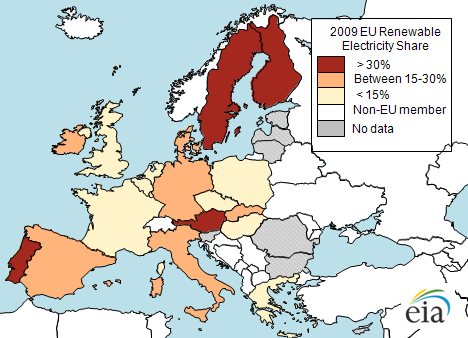博文
欧盟国家可再生能源发电达到了一个较高的高度
|||

Many European Union (EU) countries have high penetration rates of renewable electricity, with an EU-wide average of 19% in 2009. The EU countries with the highest shares of renewable electricity generation in 2009 were Austria (74%), Sweden (60%), Portugal (39%), and Finland (32%). Hydropower and biomass played major roles in each of their renewable electricity generation mixes. In contrast, the United States generated 11% of its electricity from renewables that year. In the United States, the largest contribution comes from hydropower, followed by wind and biomass.
The United States does not have a national goal on renewable energy, although 29 states and the District of Columbia had legislated renewable portfolio standards as of June 2011 (an additional 8 states have renewable portfolio goals). The EU, on the other hand, has a legally binding goal to achieve a 20% renewable energy share of total energy consumption by 2020, which includes not only electricity, but also transportation, heating and cooling. In working towards this overall energy goal, each country individually set targets for its own share of renewable electricity and created action plans to attain that target. Of the 27 plans, 20 incorporated feed-in tariffs1, or FITs, to promote renewable electricity production. These have had varied success, however, with many countries now finding it difficult to balance these incentives against the increased energy cost to consumers.
A 2011 report by the European Commission showed that only seven European nations—Denmark, Germany, Hungary, Ireland, Lithuania, Poland, and Portugal—were expected to reach their interim 2010 targets for producing renewable electricity. Despite these preliminary 2010 results for electricity, almost half of EU members still plan to surpass their overall renewable energy targets by 2020 (including energy used for transportation, heating, and cooling).
https://wap.sciencenet.cn/blog-339326-472541.html
上一篇:MIT倡导中学生通过设计来学知识
下一篇:国内首个矿井物探研究实验基地启用
全部作者的精选博文
全部作者的其他最新博文
全部精选博文导读
相关博文
- • 中国学者团队综述:血红素的生物合成等方面的最新突破和进展
- • Construction of the DIKWP Artificial Consciousness (初学者版)
- • DIKWP Whitebox Test for Cognitive (Months 24-36)(初学者版)
- • DIKWP Whitebox Test for Cognitive (Months 12–24)((初学者版)
- • Mathematizing the DIKWP Whitebox Test Using DIKWP×DIKW(初学者版)
- • DIKWP Artificial Consciousness as Infant: Months 24–36(初学者版)